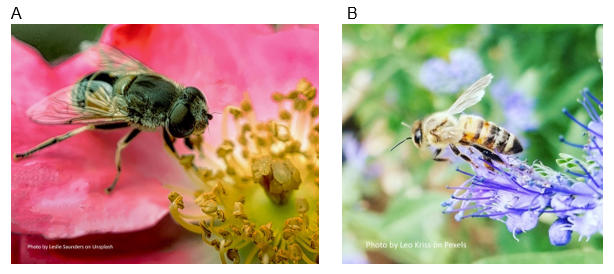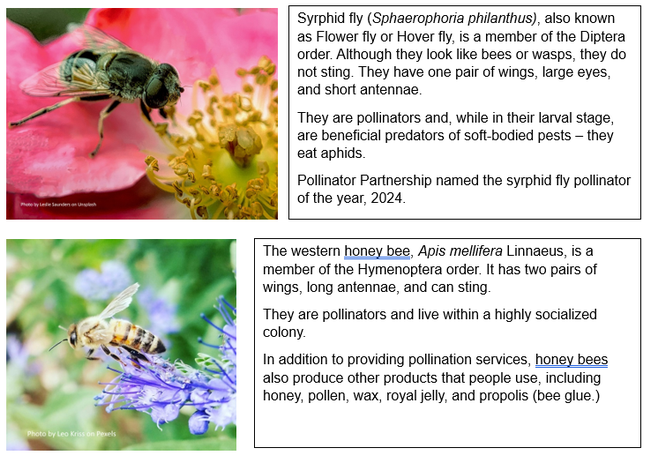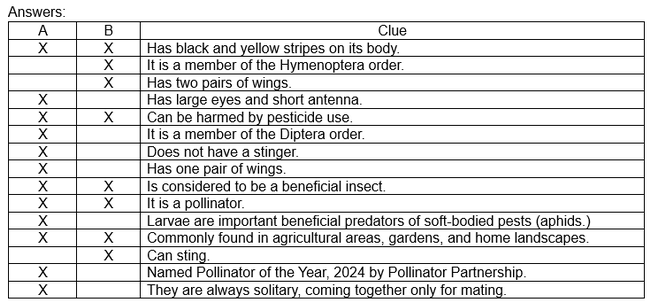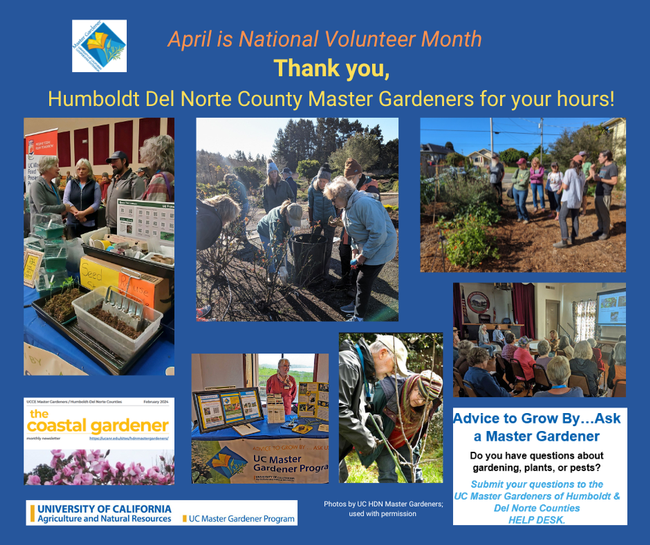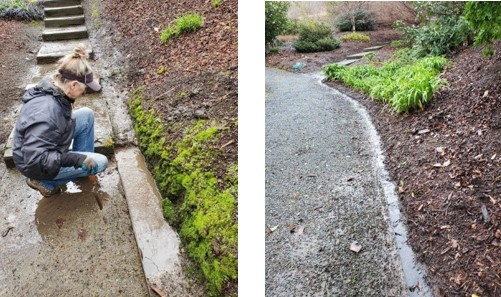- Author: Lisa Nedlan
I can name that flying insect in 3 clues – how about you?
Match the clue to the insect's image. Place an X in the appropriate column.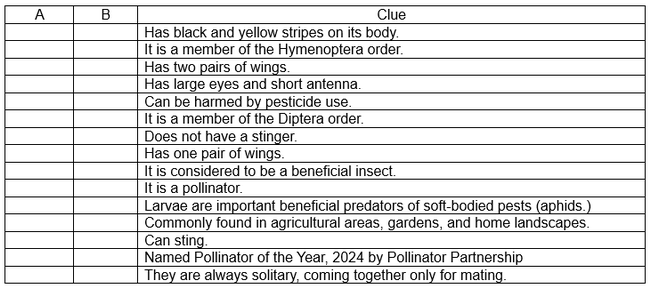
Resources:
UC IPM, Syrphids (Flower Flies or Hover Flies) https://ipm.ucanr.edu/natural-enemies/syrphids/
University of Florida, European honey bee https://entnemdept.ufl.edu/creatures/misc/BEES/euro_honey_bee.htm
University of Minnesota Extension, Syrphid flies https://extension.umn.edu/beneficial-insects/syrphid-flies
US Forest Service, Syrphid fly (Sphaerophoria philanthus) https://www.fs.usda.gov/wildflowers/pollinators/pollinator-of-the-month/syrphid-fly.shtml
Utah State University Extension, Beneficial Predators: Syrphid Flies https://digitalcommons.usu.edu/cgi/viewcontent.cgi?article=2969&context=extension_curall
Photo credits:
Honeybee photo by Leo Kriss: https://www.pexels.com/photo/macro-photography-of-honeybee-perched-on-blue-petaled-flower-754313/
Syrphid Fly photo by Leslie Saunders on Unsplash
- Author: Lisa Nedlan
April is National Volunteer Appreciation Month. We have twenty-five active Master Gardeners in our Program. We volunteer many hours each month to support the mission of the UC Master Gardener Program.
“Our mission is simple: To extend research-based knowledge and information on home horticulture, pest management, and sustainable landscape practices to the residents of California."
You can find us at local seed and plant exchanges, working and providing information at local demonstration gardens, like the Trinidad Native Garden, Humboldt Botanical Garden, and the Annie B. Ryan House and Garden, “Ask a Master Gardener” tables at the Farmer's Market, offering presentations, answering your Help Desk questions, writing articles for the Coastal Gardener Newsletter, volunteering at school gardens and more.
There are over 6,000 Master Gardeners throughout California. Master Gardeners receive extensive training from the University of California to provide research-based information to the public. In exchange for training, we volunteer in our communities, continue to learn, utilize our skills and interests, and grow.
Would you like to volunteer, need advice, and learn about sustainable gardening practices? Visit the UC Master Gardeners of Humboldt and Del Norte Counties.
Learn more about Master Gardener Programs by clicking on this link.
Want to learn more about becoming a Master Gardener? Click here.
We are planning a training class for January 2025. Use this link to let us know you are interested in this class.
APRIL:
- April 13th, Humboldt Botanical Garden Education Series, Donna Wildearth, Native Plants. Location: at the Humboldt Botanical Garden (HBG), outside Marie's Terrace. Register at https://www.hbgf.org/contact-us
- April 13th, Seed and Plant Exchange, Humboldt Grange #501. Location: 5845 Humboldt Hill Rd., Eureka, CA. 11 am to 3 pm.
- April 20th, Humboldt Botanical Education Series, Jeff Moore, Succulents, Location: CR Humanities building, room 110. Register at https://www.hbgf.org/contact-us
- April 20th & 21st, 2024 Eureka Home and Garden Show, Redwood Acres Fairgrounds. For more information, visit https://www.eurekahomeandgardenshow.com/
- April 20th, Seed Exchange, Willow Creek
- April 25th, Eureka Chapter American Rhododendron Society, Mark Akimoff, Illahe Rare Plants, Chilean Andes Plant Hunting. Location: Eureka Woman's Club. For more information: www.eurekarhody.org
MAY:
- May 3rd, Humboldt Botanical Garden's ANNUAL PLANT SALE “Plant Ahead!” MEMBERS ONLY - PREVIEW EVENT, 3 pm to 7:00 pm. Shop early for native plants, perennials, ferns, roses, succulents, herbs, and more. Memberships can be purchased at the door. Please bring boxes to transport your purchases. https://www.hbgf.org/ or call 707-442-5139.
- May 4th, Humboldt Botanical Garden's ANNUAL PLANT SALE, “Plant Ahead!” will be held from 9 am to 3 pm. Free, Open to the Public. Shop early for native plants, perennials, ferns, roses, succulents, herbs, and more. Please bring boxes to transport your purchases. https://www.hbgf.org/ or call 707-442-5139.
- May 4th and May 5th, Spring 2024 Native Plant Sale. Browse their wide selection of native plants, explore the demonstration garden and talk to local native plant experts. To learn more about the event and to sign up https://northcoastcnpsnursery.org/
- May 11th, Humboldt Rose Society Annual Plant Sale, 10 am to 4 pm. Location 1525 Harris Street, Eureka, CA. https://www.humboldtrosesociety.org/schedules
- May 18th, Annual Firewise Community Fair and Youth Ecology Day, 10 am to 3 pm. Veteran's Park, 100 Kimtu Rd., Willow Creek, CA, 95573.
- On May 19th, the 71st Annual Southern Humboldt Garden Club Flower Show, 10 am to 4 pm. Free Admission. Will be held at the Agnes J. Johnson Charter School, 73 School Rd., Weott, CA. There will be a Tea Room and an Opportunity Drawing (the monies raised are used for scholarships to local High School Seniors). Local vendors will also be present with plants and other items for sale.
- Farmer's Markets in Garberville, Miranda, and Shelter Cove will be open from May through October. For additional information, visit https://www.northcoastgrowersassociation.org/
JUNE
- Farmers' Markets in Fortuna and Henderson Center, Eureka, will be open from May through October. For additional information, visit https://www.northcoastgrowersassociation.org/
- We will have a table at the Henderson Center Farmers' Market on Thursdays, 10 am to 1 pm, June through October. Bring your gardening, landscape, plant, and pest questions, and we will get you the information you need.
- June 2nd – 8th is National Garden Week.
- June 9th, Humboldt Rose Society Rose Show. Redwood Acres Fairgrounds, Home Ec. Building, 3750 Harris St, Eureka, CA. 1 pm to 4 pm, free admission. Entries accepted - June 8, noon to 1:30 PM, June 9, 7:30- 10 AM. https://www.humboldtrosesociety.org/schedules for additional information.
- June 17th – 23rd is National Pollinator Week. Visit https://www.pollinator.org/pollinator-week for more information.
Disclaimer: All dates are subject to change. Check with individual vendors for more information.
- Author: Tim Walsh, UCCE Master Gardener
- Author: June Walsh, UCCE Master Gardener
Why, what's the matter, 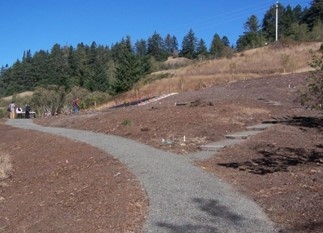
That you have such a February face,
So full of frost, of storm and cloudiness?
–William Shakespeare, from "Much Ado About Nothing"
Back in 2008, when we first began to garden, plan, and plant the Moss Family Temperate Woodland Garden in Humboldt Botanical Garden, we had a bare canvas and mostly bare earth except for the amazing load of weed seeds from the native soil and the many loads of trucked-in horse-barn shavings, spoiled feed, and manure.
We learned quickly that water flows downhill and over our beautifully compacted and rocked pathways and stairs. As the water flowed, it carried soil, eroded our new paths, and sought and took its own path. We learned where the water would run all year and where it would only run until the first of summer, and we learned to take advantage of its special qualities and behaviors.
Tim and I had been to Pukeiti Garden in New Zealand (https://www.trc.govt.nz/gardens/pukeiti/), where the prodigious rain (4 meters or 160 inches) caused the gardeners to dig 3-foot-deep and wide ‘gutters' along their pathways. They also had large culverts where the pathways crossed the rain flow. We and our volunteers learned to use trenching tools to cut gutters along our pathways to give the water a place to run without too much destruction.
When considering how to manage water runoff, think about slowing down the flow of the water, creating low-lying areas in the garden to provide short-term storage for heavy runoff, and allowing sediment and water to soak into the ground instead of entering storm drains and creeks. Also, consider planting plants with fibrous root systems along the edges to prevent runoff and soil erosion. For more information, visit https://ccuh.ucdavis.edu/sites/g/files/dgvnsk1376/files/inline-files/landdesign%20water%20quality%20english.pdf
This time of year, keeping our 16-year-old gutters free of debris is a major task for our volunteers and staff. Luckily, our deciduous trees are finished with their fall disrobement and the leaves have been removed from gutters and pathways by the Wild Weeders and Grateful Deadheaders. The leaves are repurposed into the garden beds.
During our Docent-led tour on Saturday, February 3rd, we saw the blooming Camellia reticulata along the road and the first of our brilliant pink Magnolia sprengeri var. diva 'Diva' and Magnolia ‘Caerhay's Belle' (M. sargentiana var. robusta × M. sprengeri ‘Diva'. These plants give the garden dramatic pops of color on otherwise dreary days. Tim says, “The joy of these magnolias is that they bloom in February, and the sorrow is that they bloom in February as wind and rain can strip the flowers.”
Soon the Wild Weeders and Grateful Deadheaders will begin their annual Camellia purgatory of spent blossom cleanup. We pick up the spent flowers to help prevent Camellia petal blight which is a disease caused by the fungus Ciborinia camelliae. Though our C. reticulatas are less susceptible than C. japonica or the Williams hybrids, we want to do what we can to prevent our flowers from turning brown and falling off prematurely.
Come visit the temperate woodland garden at Humboldt Botanical Garden to see how we manage water run-off, maintain the plants and soil, enjoy the lovely blossoms, and see how the garden changes throughout the seasons.
Resources:
Landscape Design & Water Quality
https://ccuh.ucdavis.edu/sites/g/files/dgvnsk1376/files/inline-files/landdesign%20water%20quality%20english.pdf
Landscape Plants: Fertilizing & Watering
https://ccuh.ucdavis.edu/sites/g/files/dgvnsk1376/files/inline-files/landplants%20fertilizing%20watering%20english.pdf
Soak Up the Rain: Rain Gardens
https://www.epa.gov/soakuptherain/soak-rain-rain-gardens
- Author: Birgitte Elbeck, UCCE Master Gardener
- Author: Jody Greaney, UCCE Master Gardener
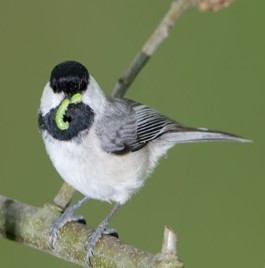
Many of us enjoy birds, but we may be inadvertently hanging “No vacancy” signs over our gardens. Research by entomologist Doug Tallamy shows that to raise their young, birds need caterpillars – lots of them. Songbirds as little as chickadees require some six to nine thousand caterpillars to raise a brood of nestlings. In fact, ninety-six percent of terrestrial songbirds rely on caterpillars to feed their babies. The prevalence of these small, soft-bodied, protein-rich larvae affects where the birds choose to nest and how big a territory they need to defend.
Fortunately, we have a good jump on knowing what these vital keystone species are. The information presented below, and the identification of keystone plant genera is based on the research of Doug Tallamy of the University of Delaware, author of Nature's Best Hope.
Here is a list of resources/databases to help you select keystone plants to support caterpillars and birds in our area:
- Calscape - Restore Nature One Garden at a Time. Enter the city where you live to see a list of native plants to choose from. You will find lots of information about each plant: images, descriptions, growth habits, and the number and types of butterflies and moths supported to name a few. (The numbers of moths and butterflies hosted indicated in the plant list below are from this search tool.)
- Audubon - Native Plants, Bring more birds to your home with native plants. Enter your zip code to see plants suited to your area and the birds they will support.
- National Wildlife Federation, Native Plant Finder Select from a list of host plants for butterflies and moths. Plants are ranked by the number of caterpillars hosted.
Using the databases above, we have put together a list of native plants that do well in our area and support butterflies and moths, which provide caterpillars to feed the birds. They all support numerous caterpillar species in our area. Numbers in parentheses indicate the probable number of caterpillar species supported.
Shrubs: Willows (211), Bitter Cherry (156), Ceanothus (85), Currants and gooseberries (85), Huckleberries (65), Wild Roses (66), Lupines (55), Manzanitas (56)
Perennials: Thimbleberry (70), Cow's Clover (67), Goldenrods (53), Beach Strawberry (32), Coast Buckwheat (31)
Annuals: Native Clovers (70), Miniature Lupine (54)
For more detailed information on these and other native plant species options for your growing conditions, visit Calscape - Restore Nature One Garden at a Time
If you would like to visit a local native garden, the North Coast CNPS, California Native Plant Society, has an extensive list of local native gardens from Trinidad to Ferndale.
Protecting The Birds That Visit Your Garden
OK! You've planted your keystone species, the caterpillars are on their way, and our feathered friends will follow. Yay!! But not surprisingly, the birds, like us, need more than just food. Here are a few steps to help you turn your avian restaurant into a home.
Reduce or eliminate pesticide use: Integrated Pest Management (IPM) strategies, such as proper plant selection, can help gardeners adopt more sustainable landscape practices.
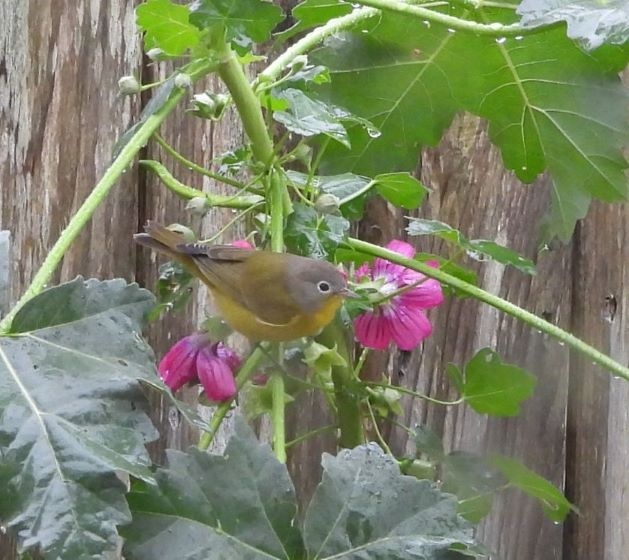
Provide Fresh Water: Place a birdbath in the landscape and be sure to keep it clean. If you are really ambitious, a small fountain with protective plants around it will attract the birds!
Add a nest box (birdhouse) - Nest boxes can provide valuable homes for many birds For more information about nest box design and placement for specific birds visit https://nestwatch.org/learn/all-about-birdhouses/.
Keep cats indoors: Free-roaming cats kill 2-3 billion birds yearly. If you want your cat to experience the outdoors, please consider building an enclosed cat patio (catio.)
Prevent window strikes: Up to a billion birds are killed every year from collisions with windows. The site below has ideas on how to prevent these accidents.
Layer your yard's habitat:
- If you have space, consider adding large shrubs or small trees such as Bitter cherry (156), Toyon (4), Coffeeberry (23), Cascara Sagrada (27), Red Alder (70), or Vine Maple (55). These trees/shrubs not only support caterpillars but can also provide fruit and nuts, nest cavities, and perches.
- Smaller shrubs, in addition to perennials and annuals, can provide cover and seeds for birds.
- Leave some decayed leaves, twigs, and other plant debris on the ground to provide homes for invertebrates that birds eat, including the pupae of most moth caterpillars.
Leave the seeds: Do not deadhead seedheads; they can be an important food source during fall and winter. Consider planting native plants such as Woolly Sunflower (Eriophyllum lanatum), California Aster (Corethrogyne filaginifolia), and Deergrass (Muhlenbergia rigens). These plants produce a profusion of seeds that attract and support seedeaters, such as finches and sparrows.
Especially for hummingbirds:In addition to soft-bodied insects and larvae, hummingbirds can feed on nectar from most any flowering shrub, tree, vine, perennial, or annual. They are especially attracted to native species with orange, pink, and red tubular flowers, such as Humboldt County Fuchsia (Epilobium septentrionale) and Hummingbird Sage (Salvia spathacea). Manzanitas, gooseberries, and currants are important for caterpillars and can also supply nectar in the colder months.
So, what are you waiting for? Now that spring planting is near, it is time to flip that “No Vacancy” sign to “Birds are Welcome!”
For more information related to protecting birds visit:
University of California, Sustainable Landscaping in California https://anrcatalog.ucanr.edu/pdf/8504.pdf
Audubon, How to Clean a Birdbath — Attracting Birds to Your Yard | Audubon https://www.audubon.org/news/why-you-should-keep-your-birdbath-clean
NestWatch, All About Birdhouses https://nestwatch.org/learn/all-about-birdhouses/
American Bird Conservancy, Cats and Birds https://abcbirds.org/program/cats-indoors/cats-and-birds/
American Bird Conservancy, Solutions for Pet Cats, Catios and Outdoor Enclosures https://abcbirds.org/catio-solutions-cats/
Cornell Lab, All About the Birds, Why Birds Hit Windows – And How You Can Help Prevent It https://www.allaboutbirds.org/news/why-birds-hit-windows-and-how-you-can-help-prevent-it/#

